Gillingham
In the late nineteenth century the professional clubs in the north of England had raised standards to such a degree that the older, amateur clubs from the south that had dominated in the 1870s and 1880s were in eclipse. Inspired by the success of a local Chatham side called Excelsior FC, a group of enthusiasts decided to establish a professional team in the Medway towns and New Brompton FC came into existence. After acquiring a plot of land on which to build their stadium (Priestfield), New Brompton joined the Southern League and won the Second Division title at the first attempt.
In 1913 the club changed its name to Gillingham FC and dropped its black and white kit in favour of red and blue shirts emblazoned with the coat of arms of Chatham Borough Council. The 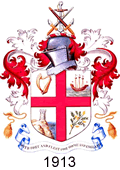 striped shirts returned after World War One but success in the Southern League continued to elude the team and in 1920 they finished bottom. They were saved from relegation, however, because the Football League decided to incorporate all the Southern League First Division teams into the new Third Division. In their first season, Gillingham finished bottom and had to apply for re-election. Fans had very little to celebrate over the next few years as the club regularly finished in or near the re-election zone. A change of colours from black and white to plain blue shirts did nothing to improve things
striped shirts returned after World War One but success in the Southern League continued to elude the team and in 1920 they finished bottom. They were saved from relegation, however, because the Football League decided to incorporate all the Southern League First Division teams into the new Third Division. In their first season, Gillingham finished bottom and had to apply for re-election. Fans had very little to celebrate over the next few years as the club regularly finished in or near the re-election zone. A change of colours from black and white to plain blue shirts did nothing to improve things 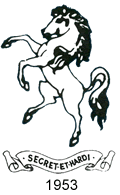 and in 1938, the club faced re-election for the fifth time in seventeen years. On this occasion they lost their place to Ipswich Town.
and in 1938, the club faced re-election for the fifth time in seventeen years. On this occasion they lost their place to Ipswich Town.
The club re-joined the Southern League and in 1949, they lifted the title. In June 1950 it was decided to extend the two regional Third Divisions of the Football League. Gillingham and Colchester United were elected to the vacant positions and after a 12-year exile, the Gills were back in the league. The euphoria of the moment was replaced by gloom and for the next ten years they finished dangerously near the re-election zone on six occasions.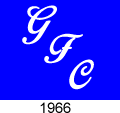
A crest was introduced in 1953 consisting of a horse rampant, a motif taken from the Kent coat of arms.
In 1964, the club had their first success when they won the Division Four title and for the following two seasons, came close to promotion 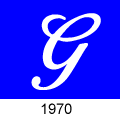 to the Second Division. By this stage crests had become unfashionable and the team took to wearing a simple "GFC" monogramme on their shirts in 1966, simplifying this even further in the 1970s.
to the Second Division. By this stage crests had become unfashionable and the team took to wearing a simple "GFC" monogramme on their shirts in 1966, simplifying this even further in the 1970s.
Performances then slumped and 1971 brought relegation, to be followed by a return to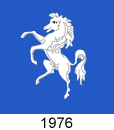 Division Three in 1974. 1976 did see the welcome return of the Kent horse to the team shirts. This appeared with various embellishments over the next nineteen seasons.
Division Three in 1974. 1976 did see the welcome return of the Kent horse to the team shirts. This appeared with various embellishments over the next nineteen seasons.
In the Eighties the Gills established themselves as one of the stronger sides in the division,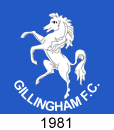 reaching the play-offs in 1987 only to slip back down to Division Four in 1989.
reaching the play-offs in 1987 only to slip back down to Division Four in 1989.
In their centenary season of 1993-94 the club incorporated the old black and white of pre-war days into their blue shirts. They also introduced a brand new crest that incorporated both old and new colours. The motto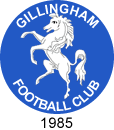 below the badge read domus clamantium, which translates from the Latin as "the home of the shouting men," a traditional epithet associated with the town of Gillingham. The horse's mane was formed from the word "Gills."
below the badge read domus clamantium, which translates from the Latin as "the home of the shouting men," a traditional epithet associated with the town of Gillingham. The horse's mane was formed from the word "Gills."
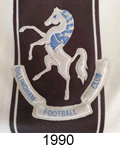 In 1996 Gillingham won automatic promotion to (Nationwide) Division Two (previously the Third Division) and then in 2000 they reached the dizzy heights of Nationwide Division One (the second tier).
In 1996 Gillingham won automatic promotion to (Nationwide) Division Two (previously the Third Division) and then in 2000 they reached the dizzy heights of Nationwide Division One (the second tier).
In 2003 the club announced that for the coming season they would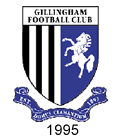 wear predominantly white shirts. This met with such an outcry that it was replaced by the black and blue hooped tops originally intended as a third strip.
wear predominantly white shirts. This met with such an outcry that it was replaced by the black and blue hooped tops originally intended as a third strip.
Gillingham slipped down the leagues and in 2008 they were relegated to League Two, the lowest tier of the Football League but bounced back after winning the League two play-off final in 2009. The popular blue and black striped kit was reinstated the following season.
